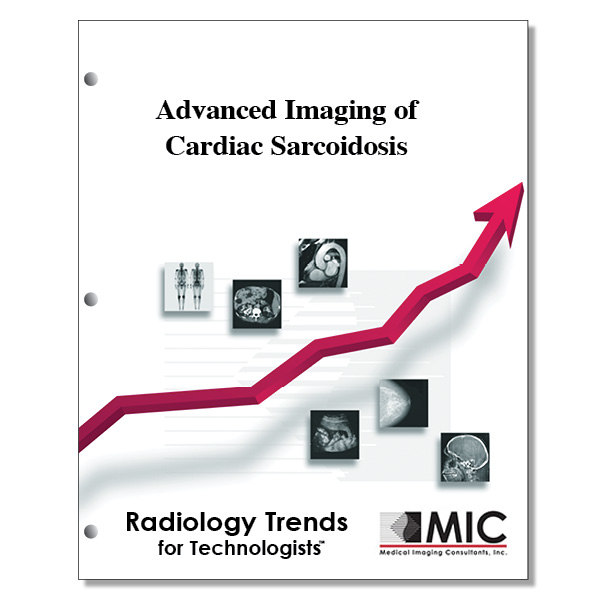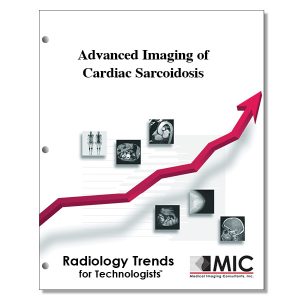

Advanced Imaging of Cardiac Sarcoidosis
A summary of the clinical background and the current state of diagnostic modalities and treatment of cardiac sarcoidosis.
Course ID: Q00421 Category: Radiology Trends for Technologists Modalities: MRI, Nuclear Cardiology, Nuclear Medicine, PET2.0 |
Satisfaction Guarantee |
$24.00
- Targeted CE
- Outline
- Objectives
Targeted CE per ARRT’s Discipline, Category, and Subcategory classification for enrollments starting after January 28, 2025:
[Note: Discipline-specific Targeted CE credits may be less than the total Category A credits approved for this course.]
Nuclear Medicine Technology: 1.00
Procedures: 1.00
Cardiac Procedures: 1.00
Registered Radiologist Assistant: 0.50
Procedures: 0.50
Thoracic Section: 0.50
Outline
Outline
- Introduction
- Clinical Manifestation
- The Need for Reliable Diagnosis
- The Missing Gold Standard
- Clinical Evaluation
- Advanced Imaging
- CMR
- PET
- Comparing PET and CMR
- Other Radionuclide Imaging Tests
- Therapeutic Options and Prognosis
- Summary
Objectives
Upon completion of this course, students will:
- be familiar with factors that have been linked with sarcoidosis
- identify the organs that are most frequently involved with sarcoidosis
- identify the area of the world where cardiac sarcoidosis is the leading cause of death
- understand the parts of the heart that are most frequently affected by cardiac sarcoidosis
- be familiar with the effects of corticosteroid treatment when provided during the inflammatory phase of cardiac sarcoidosis
- know the conditions for which patients should be considered to possibly also have cardiac sarcoidosis
- understand the four characteristics that integrate the heart’s electrical and mechanical activity
- be familiar with how some of the most frequent non-sinus arrhythmias are visualized on ECG
- be familiar with how some of the most frequent cardiac conduction problems are visualized on ECG
- be familiar with the aspects of the JMHWG guidelines for clinical diagnosis of cardiac sarcoidosis
- identify the indications for screening a patient for cardiac sarcoidosis
- be familiar with possible screening findings that can lead to further cardiac sarcoidosis work-up
- recognize endomyocardial biopsy’s role in the detection of cardiac sarcoidosis, as well as the challenges that can be present which limit its usefulness
- be familiar with how cardiac sarcoidosis presents on CMR in both the inflammatory phase and the chronic phase
- understand the implications of CMR delayed gadolinium enhancement to cardiac sarcoidosis patients
- understand the causes of increased glucose metabolism in inflammation
- understand the importance of suppression of cardiac myocyte glucose uptake for a PET-based diagnostic workup for cardiac sarcoidosis
- know the strategies currently used to suppress myocardial glucose uptake
- understand the effect of heparin on the body to suppress myocardial glucose uptake
- know the information provided from FDG PET cardiac imaging relevant to cardiac sarcoidosis management
- be familiar with the pitfalls that should be considered when observing a diffuse cardiac FDG uptake pattern
- know the condition that can be signified by diffuse or focal FDG uptake of the lateral wall
- be familiar with the various combinations of perfusion and uptake patterns when combining FDG PET with gated perfusion imaging
- be familiar with the procedures included in the cardiac sarcoidosis PET protocol described in the article
- be familiar with the terms which use probability to measure the outcomes for diagnostic examinations
- know how CMR and FDG PET compare using the JMHWG
- know the limitations of CMR in comparison to FDG PET for cardiac sarcoidosis imaging
- know the advantages of FDG PET for cardiac sarcoidosis imaging
- know the disadvantages of FDG PET for cardiac sarcoidosis imaging
- understand PET standardized uptake value, how it is calculated as well as its usefulness and its potential shortcomings
- be familiar with the radiopharmaceuticals used to detect and monitor cardiac involvement in sarcoidosis prior to the advent of clinical PET imaging
- understand how 67Ga detects cardiac sarcoidosis during its inflammatory phase
- be familiar with the basic medical treatment options for cardiac sarcoidosis
- understand the reported effects of early corticosteroid therapy on LV function
- understand why antiarrhythmic agents are often required for cardiac sarcoidosis patients
